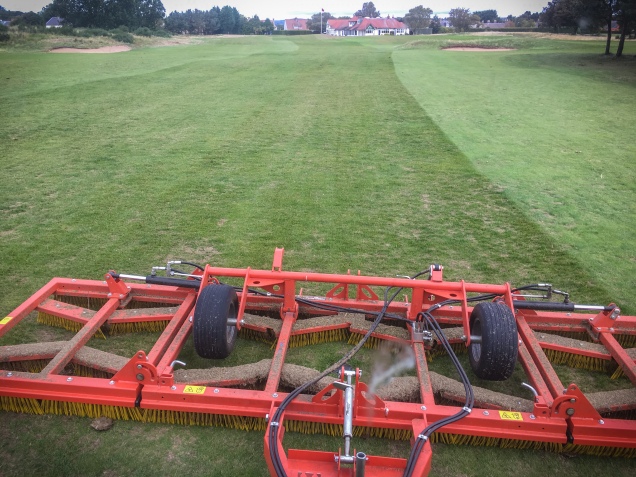
The last few weeks have been a busy time for the greenstaff.
With the seeding work completed in late July the new seedlings are already well established. Regular light feeding has been taking place along with the continuation of the growth regulator programme.

It was fairly noticeable that an application of lawn sand had taken place by the blackening of the turf. This was put on to boost the new seedlings and established turf as well as strengthen the turf against disease outbreaks. Anthracnose is prevalent at the moment and requires regular feeding of the turf and plenty of aeration to keep it at bay.

Seen here the Anthracnose only affects our Annual Meadowgrass so it is not totally undesirable. As long as it stays under control we are happy to let it kill off the undesirable grass especially as our new seedlings are establishing.
The greens have been aerated twice in the last month with a solid 9.5mm tine to a depth of around 4″. This will continue on a monthly basis until early winter when the greens will be vertidrained more deeply with a larger tine. The work is largely disruption free and virtually unnoticeable after 3 days.


A granular application of Potassium has gone out on greens as well to further strengthen the turf and also to improve soil deficiencies.
The wetting agent programme is also continuing and another application is due soon.

This has been an excellent year if you happen to be a weed and we can see a lot of Plantain and Sorrel seedlings appearing course wide.
These are being controlled by chemical applications and the fairways on the front 9 have been spot treated along with areas of semi-rough. The remainder of the course will be treated on the next available calm day. So if you are reading this blog post weeds your days are numbered…


Fairways have all been brushed against the grain and then cut in the opposite direction.
This was undertaken to lift any dead and/or matted organic material and allow more light and air to penetrate the turf canopy. This goes a long way in spring to improving turf health and it should help weak areas regenerate after the difficult summer.

With overnight temperatures cooling rapidly and growth slowing we are turning our attention to cutting and collecting areas of long rough & Gorse. The recent purchase of a larger more modern machine to do the job means we can now look to maintain a far larger area of native rough.

As the coarse grasses die out as a result of the cutting and collecting we are seeing an increase in Bent and Fescue populations. These are much finer and present far more attractive and playable roughs.


Great Chris, sets us up well for the winter. Any chance the fir cones can be removed? Saw a local course using a large fan/blower to remove them quite successfully last week.
LikeLike
Maybe not then.
LikeLike
Hi Steve, apologies, i didn’t realise you had posted a comment!
We’re trying to pick up the worst of the cones by blowing them into the long roughs where the majority get collected when we flail the grass with the new machine.
LikeLike